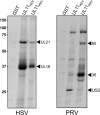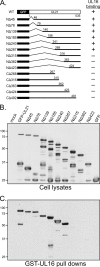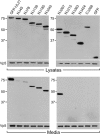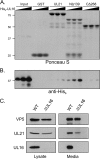Interaction domains of the UL16 and UL21 tegument proteins of herpes simplex virus
- PMID: 20042500
- PMCID: PMC2826038
- DOI: 10.1128/JVI.02015-09
Interaction domains of the UL16 and UL21 tegument proteins of herpes simplex virus
Abstract
The UL16 protein of herpes simplex virus is capsid associated and was previously identified as a binding partner of the membrane-associated UL11 tegument protein (J. S. Loomis, R. J. Courtney, and J. W. Wills, J. Virol. 77:11417-11424, 2003). In those studies, a less-prominent, approximately 65-kDa binding partner of unknown identity was also observed. Mass spectrometry studies have now revealed this species to be UL21, a tegument protein that has been implicated in the transport of capsids in the cytoplasm. The validity of the mass spectrometry results was tested in a variety of coimmunoprecipitation and glutathione S-transferase pull-down experiments. The data revealed that UL21 and UL16 can form a complex in the absence of other viral proteins, even when the assays used proteins purified from Escherichia coli. Moreover, UL11 was able to pull down UL21 only when UL16 was present, suggesting that all three proteins can form a complex. Deletion analyses revealed that the second half of UL21 (residues 268 to 535) is sufficient for the UL16 interaction and packaging into virions; however, attempts to map a subdomain of UL16 were largely unsuccessful, with only the first 40 (of 373) residues being found to be dispensable. Nevertheless, it is clear that UL16 must have two distinct binding sites, because covalent modification of its free cysteines with N-ethylmaleimide blocked binding to UL11 but not UL21. These findings should prove useful for elucidating the molecular machinery used to transmit a signal into a virion when it attaches to cells, a recently discovered mechanism in which UL16 is a central player.
Figures








Similar articles
-
Complex mechanisms for the packaging of the UL16 tegument protein into herpes simplex virus.Virology. 2010 Mar 15;398(2):208-13. doi: 10.1016/j.virol.2009.12.004. Epub 2010 Jan 3. Virology. 2010. PMID: 20051283 Free PMC article.
-
Regulated interaction of tegument proteins UL16 and UL11 from herpes simplex virus.J Virol. 2012 Nov;86(21):11886-98. doi: 10.1128/JVI.01879-12. Epub 2012 Aug 22. J Virol. 2012. PMID: 22915809 Free PMC article.
-
The Product of the Herpes Simplex Virus 2 UL16 Gene Is Critical for the Egress of Capsids from the Nuclei of Infected Cells.J Virol. 2017 Apr 28;91(10):e00350-17. doi: 10.1128/JVI.00350-17. Print 2017 May 15. J Virol. 2017. PMID: 28275195 Free PMC article.
-
Analysis of the interaction between the UL11 and UL16 tegument proteins of herpes simplex virus.J Virol. 2008 Nov;82(21):10693-700. doi: 10.1128/JVI.01230-08. Epub 2008 Aug 20. J Virol. 2008. PMID: 18715918 Free PMC article.
-
Characterization of the Herpes Simplex Virus (HSV) Tegument Proteins That Bind to gE/gI and US9, Which Promote Assembly of HSV and Transport into Neuronal Axons.J Virol. 2020 Nov 9;94(23):e01113-20. doi: 10.1128/JVI.01113-20. Print 2020 Nov 9. J Virol. 2020. PMID: 32938770 Free PMC article.
Cited by
-
CRISPR/Cas9 Mutagenesis of UL21 in Multiple Strains of Herpes Simplex Virus Reveals Differential Requirements for pUL21 in Viral Replication.Viruses. 2018 May 15;10(5):258. doi: 10.3390/v10050258. Viruses. 2018. PMID: 29762484 Free PMC article.
-
Generation and Characterization of UL21-Null Herpes Simplex Virus Type 1.Front Microbiol. 2012 Nov 16;3:394. doi: 10.3389/fmicb.2012.00394. eCollection 2012. Front Microbiol. 2012. PMID: 23162546 Free PMC article.
-
Elucidation of the block to herpes simplex virus egress in the absence of tegument protein UL16 reveals a novel interaction with VP22.J Virol. 2014 Jan;88(1):110-9. doi: 10.1128/JVI.02555-13. Epub 2013 Oct 16. J Virol. 2014. PMID: 24131716 Free PMC article.
-
Interaction and interdependent packaging of tegument protein UL11 and glycoprotein e of herpes simplex virus.J Virol. 2011 Sep;85(18):9437-46. doi: 10.1128/JVI.05207-11. Epub 2011 Jul 6. J Virol. 2011. PMID: 21734040 Free PMC article.
-
pUL21 is a viral phosphatase adaptor that promotes herpes simplex virus replication and spread.PLoS Pathog. 2021 Aug 16;17(8):e1009824. doi: 10.1371/journal.ppat.1009824. eCollection 2021 Aug. PLoS Pathog. 2021. PMID: 34398933 Free PMC article.
References
-
- Addison, C., F. J. Rixon, and V. G. Preston. 1990. Herpes simplex virus type 1 UL28 gene product is important for the formation of mature capsids. J. Gen. Virol. 71:2377-2384. - PubMed
Publication types
MeSH terms
Substances
Grants and funding
LinkOut - more resources
Full Text Sources
Other Literature Sources

